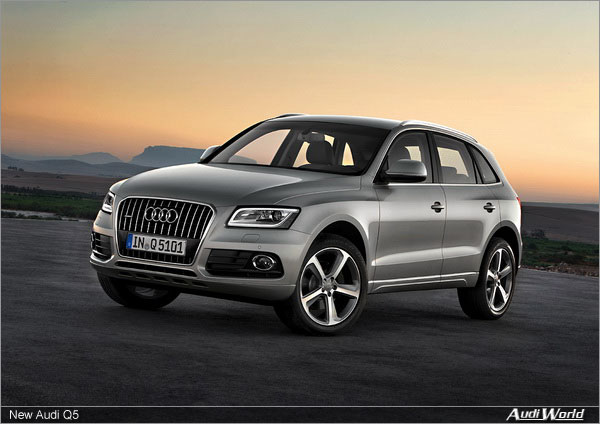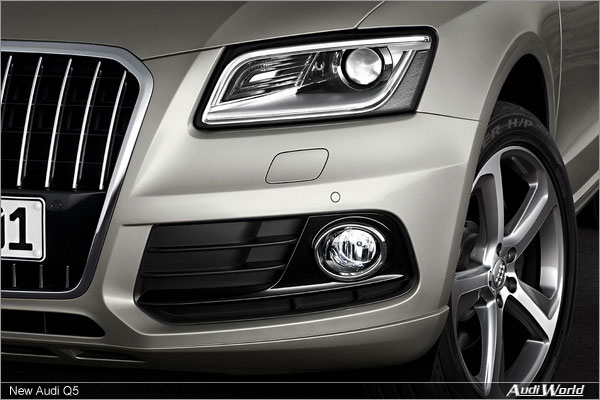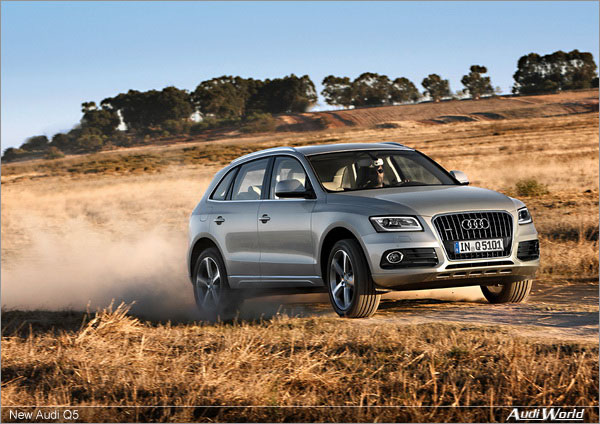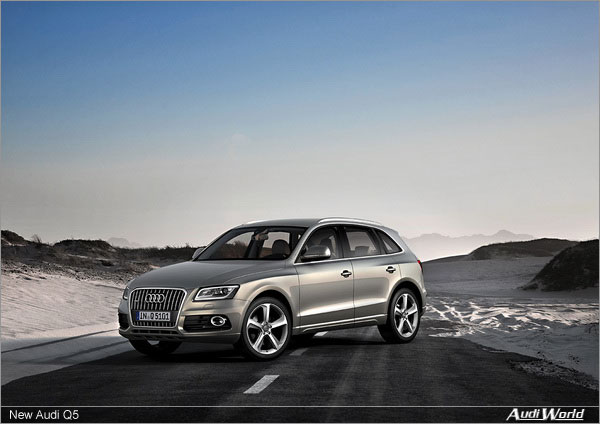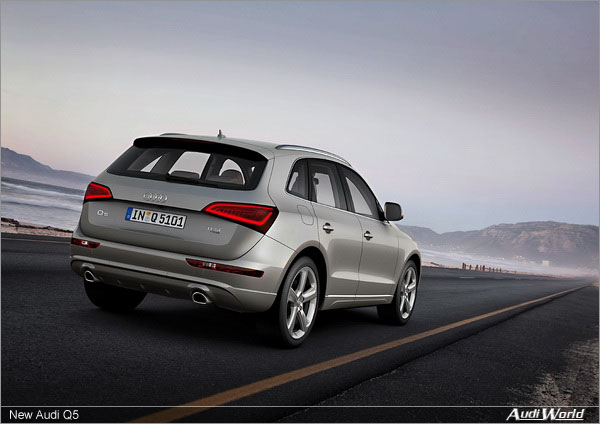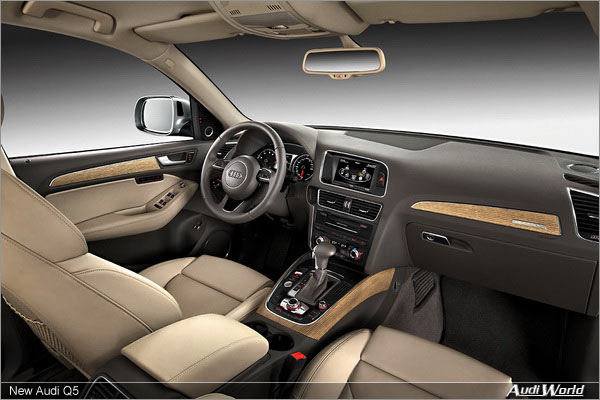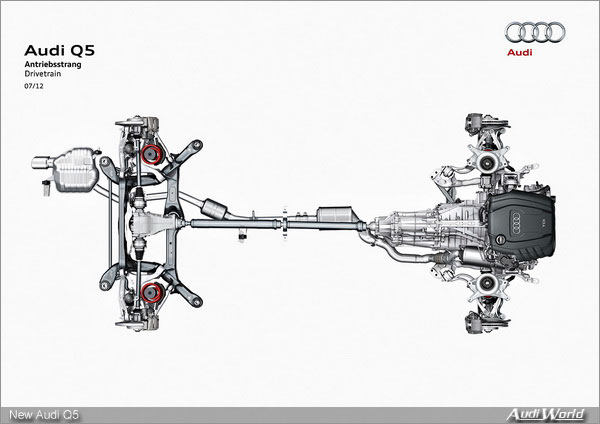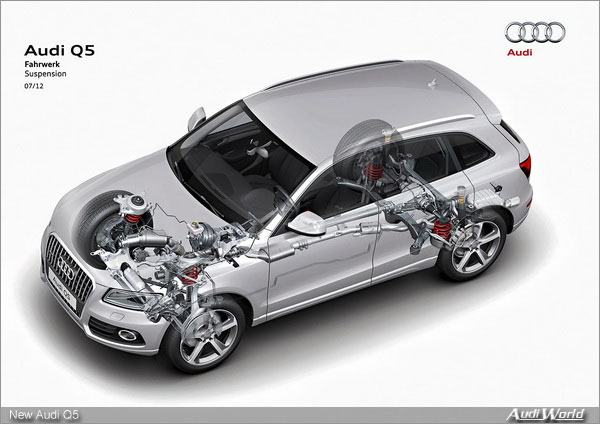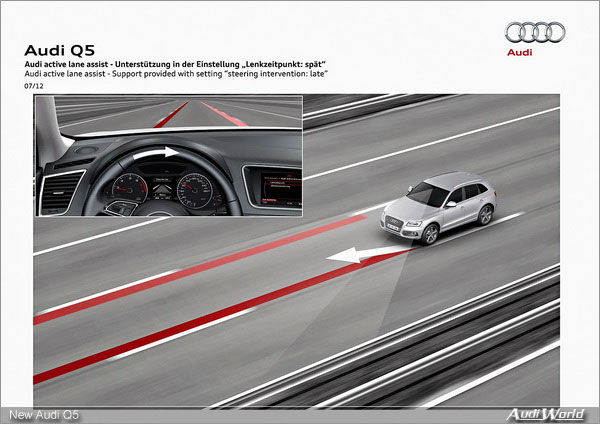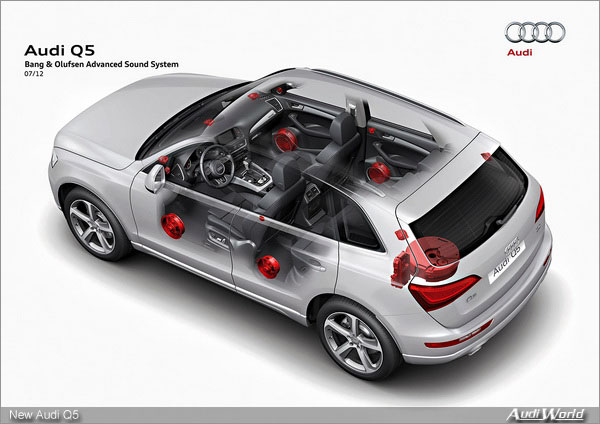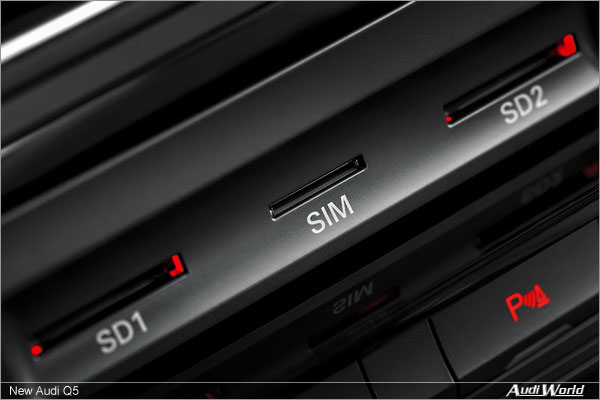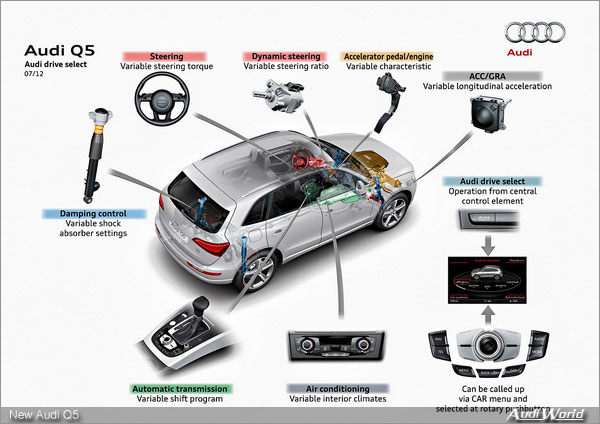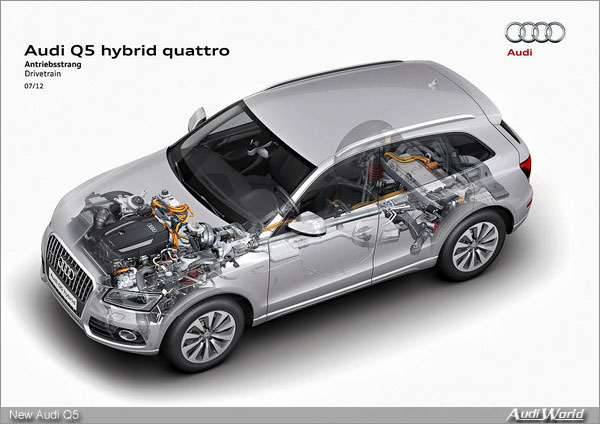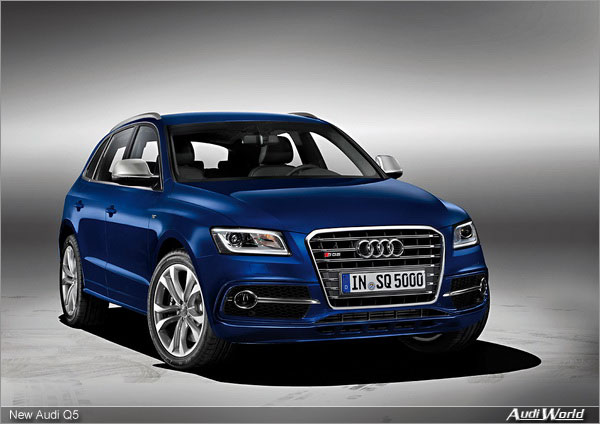The Audi Q5 – new power for a winner
The Audi Q5 combines the sports appeal of a sedan with high variability of its interior space and many practical solutions for recreation and everyday driving. Audi has further sharpened the profile of its performance SUV in this facelift – in its styling, infotainment systems, assistance systems and engines. The Audi Q5 hybrid quattro is impressive in its fuel economy, and the new SQ5 TDI – the first S model from Audi with a diesel engine – rounds out the model lineup upwards.
Sporty, attractive and versatile – the Audi Q5 performance SUV is the most successful mid-class SUV in Europe. Now it is even better – adding many new solutions in design, infotainment, assistance systems and engines. The Q5 hybrid quattro combines the power of a six-cylinder engine with the fuel economy of a four-cylinder unit, while the new SQ5 TDI showcases the dynamic potential of the model series with 230 kW (313 hp) – it is the first S model from Audi to feature a diesel engine.
The sporty design of the Q5 with its flat roof arch is now appearing in a meticulously revised and sharpened form. The single-frame grille has chamfered top corners; its vertical chrome struts and Audi rings have a sculptural look. The bumpers, air inlets and front fog lights are also new.
The optional xenon plus headlights have a continuous strip of LED daytime running lights around the edge, similar to the tail lights at the rear. The sporty S line exterior package and distinctive offroad styling package are options that strongly accentuate the looks of the Q5. The wrap-around tailgate – a typical design element of the Audi Q models – and the engine hood are made of aluminum. In the passenger cell, advanced form-hardened steels reduce weight; they are extremely strong and at the same time lightweight.
More power, less fuel consumption: engines
The 2.0 TDI is available in two versions. The version developing 105 kW (143 hp) has a combined fuel consumption of just 5.3 liters of diesel per 100 km (44.38 US mpg). The intensively advanced 3.0 TDI produces 180 kW (245 hp) of power and 580 Nm (427.79 lb-ft) of torque. It accelerates the Q5 from zero to 100 km/h (62.14 mph) in 6.5 seconds.
Another highlight of the engine lineup is the all new two-liter TFSI. This gasoline engine introduces innovative solutions – in the control of valves and their stroke, in its innovative thermal management, turbocharger, integration of the exhaust manifold in the cylinder head and the common rail system that integrates additional fuel injection into the induction manifold.
The 2.0 TFSI produces 165 kW (225 hp), yet it has a combined fuel consumption of just 7.9 liters per 100 km (29.77 US mpg) with the tiptronic transmission. Offering even more performance is the new 3.0 TFSI – this supercharged V6 increases power output to 200 kW (272 hp) with 400 Nm (295.02 lb-ft) of torque. It completes the sprint to highway speed (62.14 mph) in 5.9 seconds.
For each engine, Audi supplies a transmission that matches its output. A six-speed manual is standard for the four-cylinder engines. The sporty seven-speed S tronic is standard for the 3.0 TDI and is available as an option for the 2.0 TDI developing 130 kW (177 hp). The convenient eight-speed tiptronic is an option for the 2.0 TFSI and is standard for the 3.0 TFSI.
In the four-cylinder versions, the transmissions are integrated into the engine’s thermal management system, which significantly shortens the warm-up phase. The quattro permanent four-wheel drive with torque vectoring is standard, except for the 2.0 TDI developing 105 kW (143 hp) which is factory-equipped with front-wheel drive.
Advanced efficiency: electromechanical power steering
Electronic Stabilization Control (ESC) detects the composition of the road and adjusts its interventions accordingly; hill descent assist is standard.
The Audi drive select dynamic handling system introduces more versatility to the performance profile of the Q5. It lets the driver control the accelerator pedal characteristic, automatic transmission shift points, amount of steering assist and operation of the automatic air conditioning over four different modes, including an efficiency mode. If an Audi navigation system is installed, the user-programmable ‘individual’ mode is added.
Optional high-end components can be integrated into the Audi drive select control system as well. They include a radar-based adaptive cruise control system, chassis with damping control and dynamic steering. The latter adjusts the steering gear ratio according to vehicle speed and improves stability in sharp curves.
Versatile: driver assistance systems
The most innovative of the optional assistance systems is the further developed adaptive cruise control.
This radar-based cruise control system regulates the distance between the Q5 and the vehicle ahead; at speeds below 30 km/h (18.64 mph) it initiates hard braking if it detects an impending front-end collision. Audi active lane assist supports the driver with slight steering corrections to stay in lane, while Audi side assist monitors the space behind the vehicle, making lane changes more relaxed. Rounding out the driver assistance system lineup are three systems that make parking easier.
In the infotainment area, Audi offers a broad range of units, where MMI navigation plus represents the very top unit. This large media center has been improved in many aspects, including its voice control functionality. It is ideally supplemented by the Bluetooth online car phone that offers an integrated WLAN hotspot which lets passengers surf the Web and send emails with their mobile devices.
For the driver, the Bluetooth online car phone introduces services from Audi connect into the vehicle. They include such services as point of interest search with voice control and navigation with Google Earth images and Street View. Audi online traffic information shows the very latest traffic loads over the selected route on the navigation map. The smart phone app Audi Music stream lets users receive a large number of Internet radio stations and save favorites to a cell phone. The selected program is played over the audio system loudspeakers via WLAN.
Wellness lounge: interior
In the revised Audi Q5, customers can choose from three new interior colors and three leather and three fabric qualities; decorative inlays include three wood veneers and an aluminum version. With the S line sport package, the interior is immersed in black; sport seats and subtle trims make it even more exclusive. The Audi exclusive program and Audi exclusive line offer further attractive recommendations.
The Audi Q5 exhibits great talents for everyday driving and recreation. Its long wheelbase of 2.81 meters (9.22 ft) creates ample space for five passengers. The angle of the rear seatbacks is adjustable; when they are folded down cargo capacity grows from 540 to 1,560 liters (19.07 cubic ft to 55.09 cubic ft). Options include a rail system, cargo liner, reversible floor mat, electrically powered tailgate, folding front passenger seatback and longitudinally adjustable rear bench with load-through hatch. The trailer load is up to 2.4 metric tons – that too is a top value.
Assuming a special position within the model series is the Audi Q5 hybrid quattro, the first hybrid SUV in its segment with a standard lithium-ion battery. The powertrain consists of a 2.0 TFSI developing 155 kW (211 hp) and an electric motor with up to 40 kW (54 hp) of power. Together they produce 180 kW (245 hp) of system power and 480 Nm (354.03 lb-ft) of system torque.
The two drives are installed in series and are joined via a clutch. Their power is transmitted to the quattro drivetrain via a modified eight-speed tiptronic. The lithium-ion battery located at the rear of the vehicle stores 1.3 kWh of nominal energy, and it is cooled in two different ways depending on loads.
The Audi Q5 hybrid quattro accelerates from zero to 100 km/h (62.14 mph) in 7.1 seconds. At a constant speed of 60 km/h (37.28 mph) it can cover up to three kilometers (1.86 miles) in pure electric mode, and its peak speed in this mode is 100 km/h (62.14 mph). Combined fuel consumption is just 6.9 liters per 100 km (34.09 US mpg). The hybrid SUV can be driven with just the TFSI, just the electric drive or in hybrid mode; in addition, the powertrain features energy recovery and boosting.
The driver can choose one of three programs. The EV characteristic map prioritizes the electric drive, the D program controls the two drives to optimize fuel economy, and the S level is the sport mode. Special indicators let the driver know the drive type currently being used and its efficiency potential.
New top model: Audi SQ5 TDI
The Audi SQ5 TDI completes the sprint from zero to 100 km/h (62.14 mph) in 5.1 seconds, and its top speed is 250 km/h (155.35 mph) – yet its combined fuel consumption is just 7.2 liters per 100 km (32.67 US mpg). The sport suspension lowers the body by 30 mm (1.18 in), and its wheels are 20 inches in diameter. Up to 21-inch wheels are available as options.
Equipment and prices
The list of standard features is generous. It includes front fog lights, the high-gloss package, a roof rack, automatic air conditioning, chorus radio with 6.5-inch display, six airbags, integral head restraint system and electromechanical parking brake. The Q5 hybrid quattro also has the MMI navigation plus system, while the SQ5 TDI has xenon plus headlights and the Audi drive select dynamic handling system.
Options for the Q5 come directly from the luxury class. They include adaptive light, convenience key, panoramic glass roof, three-zone automatic air conditioning and climate comfort seats with ventilation function. The S line sport package includes sport suspension and the exclusive exterior color Daytona Gray, pearl effect.
Styling and body
Engines
Power transmission
Chassis
Interior
Equipment
The Audi Q5 is characterized by its sporty proportions; its body has flowing lines and athletically sculpted surfaces and looks as though it were carved from a single block. The tornado line running below the side windows cuts sharp edges above the wheels. The tailgate wraps around the body – a typical design element of all Audi Q models.
The roof line runs in a coupe-like arch that descends early; the A and C pillars are swept back significantly. Around the windows, the standard high-gloss package accentuates the vehicle’s styling, and a spoiler visually extends the roof line. The roof rails in anodized aluminum – or the optional black – and a crossbar are standard. The facelift has hardly changed the vehicle’s dimensions: the Q5 is 4,629 mm (182.24 in) long, 1,898 mm (74.72 in) wide and 1,627 mm (64.06 in) tall. Its wheelbase measures 2,812 mm (110.71 in), and its overhangs are short.
However, the vehicle’s styling has become more distinctive in many aspects; the front end appears lower and wider. The high-gloss black single-frame grille now has six corners, and its vertical chrome bars and the Audi rings have a sculptural look. The bumper is also new; it integrates large air inlets with high-gloss black inserts. The standard fog lights have chrome ring surrounds.
The new headlights give the Audi Q5 a resolute look. With the optional xenon plus lights, the highly efficient LED daytime running lights form a slender, visually uniform ring that almost follows the entire outer contour of the headlight unit. As an option, Audi can equip the Q5 with adaptive light, which integrates a dynamic cornering light and a static turning light.
The lights at the rear are undivided; wrap-around LED strips make their appearance in interplay with the xenon plus headlights. Because the tail lights cannot be seen when the tailgate is opened, lights have been added to the bumper on the Q5.
The diffuser insert has also been redesigned. The tailpipes of the exhaust system have chromes trim and are flattened at the bottom. The two-liter diesels have one tailpipe on the left, while all other engines have tailpipes on both sides.
Solutions for individualists: colors and add-on parts
Customers can choose from three color versions for exterior add-on parts such as the lower sections of the bumpers and the door trim strips. The standard selection is black, or they can be painted in a contrasting color or the exterior color as an option. Another sporty alternative is the black Audi exclusive styling package (not for the 2.0 TDI with front-wheel drive).
Audi has configured the S line exterior package for those who like a dynamic look. It adds sporty touches to the bumpers, air inlet screens and the platinum gray diffuser insert.
The door trim strips are in the exterior color, and the roof spoiler has been lengthened. S line badges appear on the fenders and door sill trims, and the loading-sill protector at the rear glistens in stainless steel.
The optional offroad styling package from the Audi exclusive program gives the Q5 an exceptionally rugged look. Modifications here relate to the bumpers, air inlet screens, door trim strips, door sill trims and the loading-sill protector. Plastic add-ons extend the wheel housings, and stainless steel panels protect the underbody at the front and rear. The offroad styling package is available in conjunction with large wheels from the Audi exclusive program.
The curb weight of the Audi Q5 2.0 TDI developing 105 kW (143 hp) without driver is 1,680 kg (3703.77 lb) – an excellent value in this vehicle class. When it was launched on the market four years ago, the body won the European Car Body Award – the world’s most prestigious award in car design.
The Audi Q5 body consists of an intelligent mix of materials. The tailgate and engine hood are made from aluminum panels; the tailgate alone weighs 8.1 kg (17.86 lb) less than an equivalent steel part. The front cross member and its crash boxes are made of aluminum profiles; together they weigh less than 5.0 kg (11.02 lb).
The occupant cell integrates form-hardened steels in many areas; these steels attain extreme levels of tensile strength due to a drastic temperature change during forming. They are able to perform with low wall thicknesses that make them extremely lightweight. In total, they weigh 44 kg (97.00 lb), 15 kg (33.07 lb) less than conventional parts. Tailored rolled blanks – metal sheets of varying thickness – in the rear floor area reduce the weight by 1.9 kg (4.19 lb).
In the body-in-white of the Q5 – without doors, lids or sheet metal skin –, form-hardened steels make up 9.1 percent of the total weight. 3.3 percent comprises ultra-high-strength steels, 12.3 percent advanced high-strength grades, 44.5 percent high-strength steels and 30.8 percent deep-drawn steels.
Precise to tenths of a millimeter: body structure
The body’s high level of rigidity forms the basis for a quiet atmosphere in the passenger compartment, a comfortable ride and precise sporty handling. The occupant protection system is also top notch. In the event of a front-end collision, the front cross member distributes forces to the upper and lower side members. The aluminum subframe for the front axle and engine redirects forces into the floor and tunnel structure. In the event of a rear-end crash, the side members, rear wheels and side sills absorb the impact energy along defined paths. In a side-on crash, the B-pillars, side sills and two cross members in the floor perform a majority of the deformation work.
The restraint systems of the Q5 are precisely tuned to the body’s deformation properties. In a front-end crash, they consider – based on input from sensors – the seating positions of the driver and front passenger in their triggering actions; this enables very good protection of persons of any size. In collisions involving pedestrians, the Audi Q5 fulfills all key regulations thanks to its large deformation spaces and a foamed zone behind the bumper. The aluminum crash boxes in front of the side members ensure that the body structure remains undamaged in collisions up to a speed of about 15 km/h (9.32 mph).
The Audi Q5 makes a clear statement in its drag coefficient or cD value of 0.32 or 0.33 – which is made possible by intensive design refinements to the outer skin, underbody and engine compartment. Its frontal area measures 2.65 m2 (28.52 sq ft). Elaborate aero-acoustic modifications ensure low noise levels, even at high speed. Such details as three-fold door seals, rain channels at the A pillars and the exterior mirror design have a significant effect here.
The interior of the Audi Q5 has a sporty look, its styling is elegant and light, and its controls – already intuitive and simple – have been further improved. The steering wheels have been redesigned – with four or three spokes in the Q design. A flat-bottomed steering wheel with a new multifunction key layout and shift paddles is available as an option. In controlling the automatic transmission from the gear selection lever, it is now easier to switch to the S program; this just requires a single button press.
The new, highly-efficient automatic air conditioning system also exhibits improvements. The optional seat heating and ventilation features can be adjusted over three levels directly from control keys. The displays on the center console are illuminated in white, the instrument needles have been upgraded, and the steering wheel stalks and ignition key have been redesigned.
The optional MMI navigation plus now performs its tasks with just four fixed keys for the Navigation, Telephone, Radio and Media areas. The volume dial has a skip function for advancing through song titles. Only one button is now needed to operate the Audi drive select dynamic handling system – another optional feature.
The front seats – both with height adjustment – offer excellent body motion control and support. An adjustable center armrest with a storage compartment and drink holders is standard. As an option, Audi can install electrically adjustable seats, with a memory function on the driver’s side, and four-way electric lumbar support. Seat heating is also an option for the rear outer seats.
The soft upholstered climate-controlled comfort seats with their perforated leather covers are an especially luxurious option. They can be ventilated over six stages by small fans. If the system detects that excessive cooling is occurring, seat heating is automatically activated. Sport seats with lumbar support and removable seat cushions are available as an alternative in the S line sport package, the Audi exclusive line and in some design packages.
All Q5 passengers enjoy plenty of space for head, arm, legs and feet, and vehicle entry is also very comfortable. The seatback angles of the rear bench seat can be adjusted over a range of 24 to 30 degrees, and the L-shaped head restraints hardly affect visibility in the interior mirror. Other options that make life in the vehicle more convenient are temperature-controlled drinks holders and a versatile storage package.
Material selection and usage reflect uncompromising quality thinking at Audi; the Q5 interior has been further refined. The panel on the instrument cluster is gray, and the insert on the center console around the automatic air conditioning panel and radio is high-gloss black. Controls for air conditioning and infotainment, the window lift buttons, air nozzles and mirror adjustment switches have elegant chrome rings.
Standard inlays in the Audi Q5 are plastic in monometallic platinum and truffle beige. Available options include aluminum and three qualities of wood: walnut burl balsamico brown, ash grain brown naturelle and the sophisticated wood veneer oak beaufort. Piano finish black, carbon fiber reinforced plastic (CFRP) and six qualities of fine wood from the Audi exclusive program round out the available options.
Elegant: new interior colors
As an alternative to cloth upholstery, Audi offers the leather qualities Milano and Fine Nappa as well as an Alcantara/leather combination. A wide variety of leather packages and combinations from the Audi exclusive program, including the top-quality Valcona, complete the lineup. For the headlining, Alcantara is available in two colors.
In the Audi exclusive program, there are other recommended customized interiors, including the Audi exclusive line. Its basic color is black, and the sport seats are upholstered in two-tone Fine Nappa leather. The center panels are alabaster white, cognac and cloudy gray.
The S line sport package immerses the interior in black. Seat cover choices are a cloth/leather mix, an Alcantara/leather combination and Fine Nappa leather; the seatbacks display embossed S line logos. Gray contrasting seams (not for Fine Nappa) provide visual highlights. Other fine details are found on the steering wheel, gear shift or gear selection lever and floor mats. Inlays are in matt brushed aluminum or piano finish black. The S line sport package is rounded out by sport seats, S line sport suspension, 19-inch wheels, badges on the car body and door sill trims as well as a stainless steel loading-sill protector.
Spacious: luggage compartment
The size of the luggage compartment can be conveniently increased by latches in the side walls. When they are pulled, the split rear bench seatbacks – which are pretensioned by springs – automatically drop onto the seat cushions. If the levers are actuated while the seatbacks are down, they are lifted back up by about 45 degrees. The extended cargo space offers 1,560 liters (55.09 cubic ft) of capacity and a maximum load length of 170 cm (66.93 in).
Under the removable cargo floor there is an additional compartment for which a dirt-resistant tray can be ordered. Other optional features include an electric drive for the tailgate, a rail system with load-securing set and a reversible floor mat.
The optional rear bench seat plus offers up to 100 mm (3.94 in) longitudinal adjustment, and it comes with a load-through hatch for cargo; it can be supplemented by an optional bag for skis and snowboards. A front passenger seat with fold-down seatback is another option that increases cargo capacity significantly.
The accessories program offers many different racks for transporting bikes, kayaks, surfboards and skis. Depending on the engine, the Audi Q5 can tow trailers up to 2.4 metric tons in weight (on a 12 percent gradient).
The engine lineup for the Q5 showcases the bundled technological know-how of Audi. Fuel economy was improved by up to 15 percent in the three TDI and two TFSI engines, even though most units gained in power and torque. All engines are turbocharged direct-injection units with high torque. The start-stop system – which also operates at low temperatures thanks to a powerful battery – is standard with all engines; even the cooling fan was optimized for maximum efficiency.
The modified 2.0 TDI, which works with 1,968 cc of engine displacement, is available in two versions. Its technical finesses are its low internal friction, turbocharger with adjustable guide vanes and centrifugal pendulum in the dual-mass flywheel. This makes the engine run even more quietly at low speeds, and it enables earlier upshifting and therefore more efficient driving.
The first version, the 2.0 TDI, produces 105 kW (143 hp) and 320 Nm (236.02 lb-ft) of torque; this torque is available from 1,750 to 2,500 rpm. The four-cylinder engine has a combined fuel consumption of 5.3 liters of diesel per 100 km (44.38 US mpg) – equivalent to 139 grams per km (223.70 g/mile) CO2. Acceleration from zero to 100 km/h (62.14 mph) takes 10.9 seconds, and its top speed is 192 km/h (119.30 mph).
The second version of the two-liter engine boosts power to 130 kW (177 hp) and torque to 380 Nm (280.27 lb-ft), also from 1,750 to 2,500 rpm. With the S tronic, the sprint to highway speed (62.14 mph) is completed in 9.0 seconds, and it reaches its top speed at 200 km/h (124.27 mph). The powerful 2.0 TDI has a combined fuel consumption of 6.0 liters of fuel per 100 km (39.20 US mpg) with CO2 emissions of 159 grams per km (255.89 g/mile).
The top engine of the TDI lineup is the completely redesigned 3.0 TDI, which mobilizes 2,967 cc of displacement. Its key properties are its low weight of slightly over 190 kg (418.88 lb), an energy-saving chain drive, low internal friction, demand-regulated oil pump and complex thermal management system: the crankcase and cylinder heads have separate cooling circuits that are interconnected by control valves.
The V6 diesel produces 180 kW (245 hp) and transfers 580 Nm (427.79 lb-ft) of torque to the crankshaft between 1,750 and 2,750 rpm. It accelerates the Q5 from zero to 100 km/h (62.14 mph) in 6.5 seconds and to a top speed of 225 km/h (139.81 mph). It has a combined fuel consumption of just 6.4 liters of fuel per 100 km (36.75 US mpg), which is equivalent to 169 grams CO2 per km (271.98 g/mile).
Completely new: 2.0 TFSI
The new four-cylinder engine exhibits a torque curve like a TDI – it attains its maximum torque of 350 Nm (258.15 lb-ft) at a low 1,500 rpm and maintains it at a constant value up to 4,500 rpm. It outputs its full 165 kW (225 hp) of power at a low 4,500 rpm. With a manual transmission, the 2.0 TFSI accelerates the Audi Q5 from zero to 100 km/h (62.14 mph) in 7.6 seconds (tiptronic: 7.1 seconds) and to a top speed of 222 km/h (137.94 mph).
Its combined fuel consumption is only 7.6 liters of fuel per 100 km (30.95 US mpg) (with tiptronic: 7.9 liters [29.77 US mpg]) – equivalent to CO2 emissions of 176 (184) grams per km (283.24 [296.12] g/mile).
One innovation in the 2.0 TFSI is the addition of indirect fuel injection. This supplements FSI direct gasoline injection under part-load conditions, improving fuel economy and reducing particulate emissions. FSI injection, which operates at up to 200 bar pressure, is utilized at engine start and higher loads. In terms of filling the combustion chambers, engineers have implemented new degrees of freedom: both camshafts can be adjusted as necessary; on the exhaust side, the Audi valvelift system varies valve stroke over two stages as well.
In the innovative thermal management system, two rotary vanes incorporated in one module regulate the flow of coolant. They ensure that the engine oil heats quickly to its operating temperature after an engine start, and they regulate coolant temperature between 85 and 107 degrees Celsius depending on the driving situation. This achieves an optimal relationship between minimal friction and high thermodynamic efficiency under all load and engine speed conditions.
The exhaust manifold of the four-cylinder engine is integrated in the cylinder head where coolant circulates around it. This solution reduces the temperature of the exhaust gas, which improves fuel efficiency during a sporty mode of driving, because it avoids full-throttle enrichment. A newly developed turbocharger also makes its appearance here. Its key improvement is an electric wastegate adjuster, which regulates charge pressure extremely fast and precisely – making engine response even more spontaneous.
Internal friction has been significantly reduced as well – by a new type of coating on the piston skirts and a low-friction bearing on the two balancer shafts for very smooth engine running. The regulated oil pump consumes very little energy.
Top gasoline engine: the 3.0 TFSI with supercharger
The supercharger is located after the throttle valve, which improves its efficiency. Short gas pathways downstream result in an early and steep rise in the torque curve. Various actions have been taken to acoustically isolate supercharger noise; a balancer shaft in the engine’s lightweight alloy crankcase improves smooth running properties. Adjustable intake camshafts and flaps in the induction channels assure optimal filling of the combustion chambers.
The 3.0 TFSI, which produces its power from 2,995 cc engine displacement, is a powerful and resonant-sounding engine. It outputs 200 kW (272 hp) and produces 400 Nm (295.02 lb-ft) of torque between 2,150 and 4,780 rpm. The standard sprint to 100 km/h (62.14 mph) is completed in 5.9 seconds, and its acceleration ends at 234 km/h (145.40 mph). The engine’s standardized fuel consumption value is just 8.5 liters per 100 km (27.67 US mpg) – with CO2 emissions of 199 grams per km (320.26 g/mile).
Each version of the Q5 is factory-equipped with a transmission tailored for it – a six-speed manual transmission, sporty seven-speed S tronic or the convenient eight-speed tiptronic. All transmissions are characterized by a high level of efficiency, precise operation and wide selection of gear ratios: the lower gears have close, sporty ratios, while the upper gears have wide ratios to reduce engine revs. The differential is located in front of the clutch and the torque converter, which shifts the front axle to a far forward position. This results in a longer wheelbase and a well-balanced distribution of axle loads.
Among the four-cylinder engines, a manual transmission is standard. Its weight is low, and the method used to mount the shifter forks decouples the gear shift lever from vibrations. The driver information system with an efficiency program, which is standard on the Q5, includes a gear shift indicator. The manual transmissions are coupled to the engine’s thermal management system. A heating circuit in the heat exchanger quickly brings the transmission fluid up to temperature after a cold start; if the engine coolant is hot enough, a portion of its heat is transferred to the transmission.
The eight-speed tiptronic, standard in the 3.0 TFSI and an option in the 2.0 TFSI, is new to the Q5 model series. One factor contributing to the high efficiency of the fast and very comfortably shifting torque-converter transmission is a highly efficient oil pump. Another is heating of the transmission fluid within the thermal management system. A hydraulic reservoir supports start-stop functionality: When the engine is restarted, stored fluid is pressed into the system – and the tiptronic is ready to start within a very short time.
The seven-speed S tronic is standard with the 3.0 TDI and is an option in the 2.0 TDI developing 130 kW (177 hp). It is the most sporty transmission system in the Q5, and it consists of two sub-transmissions served by two clutches. Sequential shifting is performed by switching over the clutches; this takes just a few hundredths of a second and occurs nearly imperceptibly. As in the eight-speed tiptronic, the S tronic controller offers a fully automatic mode with the D (Drive) mode and S (Sport) mode; as an alternative, the driver can shift gears manually.
The quattro permanent four-wheel drive is standard for all engine versions except the 2.0 TDI developing 105 kW (143 hp), which drives the front wheels. The central component in the drivetrain is the limited-slip center differential. In normal driving, it distributes 40 percent of engine power to the front wheels and 60 percent to the rear wheels. If wheel slip occurs, most of the power is shifted to the other axle – up to 70 percent can be shifted to the front and up to 85 percent to the rear.
Wheel-selective torque control is an ideal supplement to the quattro drive system. In fast curve driving, the intelligent software solution detects when one of the wheels on the inside of the curve is about to lose its grip. Just before slip occurs, it brakes the wheel with a very slight, nearly imperceptible intervention – this improves handling and makes driving even safer.
The Audi Q5 is the most sporty SUV in its class thanks to its dynamic chassis. It now appears with new tuning and better balance of the spring, shock absorber and stabilizer characteristics.
The five-link front suspension, which has a track width of 1,617 mm (63.66 in) (2.0 TDI with front-wheel drive: 1,625 mm [63.98 in]), can handle longitudinal and transverse forces independently. In the transverse direction, its bearing supports are tuned for rigidity and thus for sporty precision, while they are comfortably soft in the longitudinal direction.
Many front suspension components are made of aluminum to reduce unsprung masses. This involves the integral load frame for the engine and axle, which is firmly bolted to the front end to increase rigidity, around the bearing block, and which joins the upper suspension link to the body, around the pivot bearing and around the five links per wheel. The tubular stabilizer also saves on weight.
The new electromechanical power steering system does not consume any energy in straight-line driving, which reduces fuel consumption by up to 0.3 liters (0.08 US gallons) per 100 km (62.14 miles). Its electric motor is integrated in the steering gear in a space and weight-saving design. The new steering system, which adapts its power assist to vehicle speed, has direct gearing with a gear ratio of 15.9:1; its feedback is spontaneous and precise. The turning circle of the Audi Q5 measures about 11.6 meters (38.06 ft) in diameter.
The car has a self-tracking trapezoidal-link rear suspension, which combines low space requirements with superior driving properties. A steel cross member forms the high-strength backbone; it is joined to the body with large rubber mounts.
The trapezoidal link, wheel carriers, overhead transverse links and tie rods all consist of aluminum. As in the front suspension, tubular stabilizers have been weight-optimized here too.
The springs are supported directly on the wheel carriers and are mounted independent of the compressed gas shock absorbers, so that they can respond with high sensitivity. As an option, Audi can install the stiff S line sport suspension (standard with the S line sport package). In the Q5 2.0 TDI developing 105 kW (143 hp) and the Q5 hybrid quattro the entire body structure is lowered by 25 mm (0.98 in). The rear track width measures 1,614 mm (63.54 in) (2.0 TDI developing 105 kW: 1,620 mm [63.78 in]).
Five cars in one: Audi drive select
Other components can be incorporated in the system as options, including a chassis with damping control. Its CDC shock absorbers (CDC: continuous damping control) utilize electromagnetically controlled valves to regulate the flow of the hydraulic fluid between the damper tubes. The control module individually computes the current required for each damper in cycles of just milliseconds; it also considers the condition of the road, the driver’s shifting style and the Audi drive select mode.
Another optional module that is subject to management by Audi drive select is dynamic steering. The centerpiece of this high-end system, which now also operates electromechanically, is a superimposition gearbox in the steering column, which is driven by an electric motor. This so-called shaft gearbox can vary the steering ratio by nearly 100 percent.
In city traffic, the dynamic steering system gives the driver a very direct feel for the road, while at high speeds, i.e. on expressways, it is intentionally indirect. At the performance limits of curve driving, it can minimize understeer and oversteer due to load alteration effects; its lightning-fast interventions make it unnecessary to use a lot of braking pulses. When braking on surfaces with split friction values, the system counteracts pulling to one side.
From 17 to 20 inches: wheels
The brakes of the Audi Q5 have large dimensions. Four-cylinder engines have 320 mm (12.60 in) front discs and 300 mm (11.81 in) rear discs. In the internally ventilated front brakes, hundreds of small metal cubes join the two halves of the brake discs; these cubes can dissipate a lot of hot air in a very short time. As an option, Audi can add a hold assist function to the standard electromechanical parking brake.
On the Q5 3.0 TDI and the 3.0 TFSI, all four discs – 345 mm (13.58 in) front discs and 330 mm (12.99 in) rear discs – are internally ventilated. The fixed calipers, produced as aluminum composites, are distinguished by their low weight and high strength.
In components with stringent requirements, high-strength ductile cast iron is used; the aluminum brake piston housing conducts heat away very well.
Electronic Stabilization Control (ESC) in the Q5 is a highly advanced system. In conjunction with the electromechanical steering system, it supports the driver in braking and countersteering on roadways that are slippery on one side.
The system uses a sensor to detect whether a roof crossbar is mounted, since this shifts the center of gravity of the Q5 upwards, and it adapts its control work accordingly. In the Q5 2.0 TDI developing 105 kW (143 hp), the ESC system integrates the electronic limited-slip differential – a software solution that increases stability in fast curve driving by applying minimal brake interventions to the front wheel on the inside of the curve.
Another feature integrated in ESC is offroad detection, which detects the composition of the road and is activated by a pushbutton. During acceleration, the system improves forward propulsion on loose substrates by tolerating more slip. On a steep descent, hill descent assist, which is also standard, maintains a constant vehicle speed over a range between 9 and 30 km/h (5.59 to 18.64 mph).
The Audi Q5 with a quattro drive system cuts a good figure offroad as well. Its axles permit a diagonal offset of up to 160 mm (6.30 in), and its climbing ability is very high at 31 degrees. Short overhangs enable approach and departure angles of 25 degrees each. The SUV’s ramp angle is 17.6 degrees, and its maximum side gradient is 25 degrees. Ground clearance is 20 cm (7.87 in), and it has a fording depth of up to 50 cm (19.69 in).
The updated Audi Q5 also drives with assistance systems that are at the top of its class. The first system is the standard driver information system with driving break recommendation, which is activated from a speed of 65 km/h (40.39 mph). It monitors steering movements and other parameters; if it recognizes waning concentration of the driver, it recommends a stop to take a break from driving.
The most complex of the optional systems is adaptive cruise control. Over a speed range from 30 to 200 km/h (18.64 to 124.278 mph), ACC maintains a desired distance to the vehicle in front of the Audi Q5 by monitoring the gap with radar and autonomously accelerating and braking within certain limits. The driver can set the distance and the control dynamics over multiple stages.
If ACC detects an impending front-end collision with a moving vehicle, the pre sense front system supports the driver and warns him or her over several stages. The first stage utilizes a gong and a red signal light; the braking system hydraulics are prepared, and the brake pads contact the discs. When the driver presses the brake pedal now, braking occurs practically instantaneously. If the driver does nothing, the second stage is initiated with a warning jolt and a brief braking action. If the driver now brakes but presses the pedal with insufficient force, brake assist increases the braking force to a level appropriate to the situation.
If the driver still does not react, the system autonomously initiates a partial braking action – it brakes the Q5 at a deceleration rate of about 3 m/s2, which is approximately one-third of the possible rate. At speeds below 30 km/h (18.64 mph), the performance SUV can autonomously brake with full braking force in an emergency – regardless of whether the vehicle ahead is moving or stationary. At speeds below 20 km/h (12.43 mph), this hard braking can often prevent an accident altogether, and in other cases it significantly reduces the speed at impact and therefore the accident severity.
Looking back with radar: Audi side assist
Audi active lane assist, which is activated from 65 km/h (40.39 mph), detects lane lines on the road via a small camera mounted to the interior mirror. If the Q5 approaches a line without the turn signal activated, the system helps the driver to steer back into the lane by a slight intervention in the electromechanical steering system. The driver can decide independently when the intervention should occur and whether it should be combined with a vibration in the steering wheel. If the driver chooses early correction, the system helps to keep the Q5 in the center of the given lane.
Three solutions are offered for making parking easier. The top system is park assist plus with a reversing camera. It monitors the area behind the vehicle with a fish-eye lens that is integrated in the tailgate. The images are enhanced and displayed on the MMI monitor; auxiliary lines and surfaces are shown which help the driver to steer.
The lineup of infotainment systems in the Audi Q5 has a modular structure. The basic system is the standard chorus radio system with a CD drive and amplifier that drives eight loudspeakers with a power output of 80 Watt. The system, which follows the Audi MMI user interface concept, is connected to a monochrome 6.5-inch monitor.
The first upgrade stage is the concert radio system, also has an Aux-In port, a SDHC card reader and a 6.5-inch color monitor. The next stage is the symphony radio system, which adds a CD changer for six CDs. Above this stage, there is the MMI navigation unit, which reads card data from a DVD.
The driver can input a destination by voice control, and the driver is guided underway by dynamic navigation that utilizes TMC (Traffic Message Channel). A triple tuner assures reliable radio reception.
High-end unit: MMI navigation plus
The 7.0-inch monitor of the MMI navigation plus system impresses with a high resolution of 800 x 480 pixels – it displays remarkably sharp images in brilliant colors. The system’s improved voice control function lets the driver input city and street in one voice command and control telephone and music playback as well.
The system can connect to cell phones and mobile players via a Bluetooth interface – so it can also play back their music data.
The infotainment lineup includes yet other components, including a dual tuner for digital radio reception, a TV tuner, CD changer in the glove box and the Audi music interface to connect to a mobile player or an iPhone. The Bluetooth interface and Bluetooth cell phone preparation with a hands-free unit and voice control make telephoning very convenient. Audi Entertainment mobile, an option from the accessories program, consists of one or two 9.0-inch tablets that can be mounted onto the seatbacks of the front seats and has a remote control and DVD drive.
Hi-fi fans can order the Audi Sound System in which a 180-Watt six-channel amplifier drives ten loudspeakers, including a subwoofer and a center speaker. The Bang & Olufsen Sound System offers even more great sound. Its ten-channel amplifier outputs 505 Watt and drives 14 high-performance loudspeakers whose grilles sport aluminum accents. In conjunction with MMI navigation plus, the system can play back DVDs in 5.1 surround sound.
The brand uses the term Audi connect to refer to all applications and developments that network its automobiles with the Internet, the owner, the traffic infrastructure and other vehicles. The necessary hardware module here is the Bluetooth car phone online, which serves as a supplement to MMI navigation plus; it produces the online connection via a UMTS module.
Audio connect is controlled by the MMI terminal, multifunction steering wheel or voice control. Telephone and data transmissions are made via the roof antenna and are encrypted based on the WPA2 standard. All that is required to go online is to insert a data-enabled SIM card into the card reader. As an alternative, the driver can connect a cell phone directly via the SIM Access Profile.
The WLAN hotspot, one of the system’s integrated features, lets passengers connect up to eight mobile end devices to the Q5; they can then surf and email freely.
For the driver, the system offers customized services – including travel and weather information. At the www.myAudi.de website, drivers can plan their route on a home computer in advance, save it under their profile, then load it into the car before heading out. If desired, the driver can view the map with background aerial and satellite images from Google Earth.
An especially attractive service is Audi online traffic information – it displays data describing the latest traffic flow on the navigation map. If traffic is flowing freely over the selected route, it is shown in green; yellow indicates heavy or slow-moving traffic and red signifies a traffic jam. In this case, the service displays a text describing the traffic problem and recommends a viable detour.
The Audi system operates faster, more precisely and more comprehensively than conventional TMC and TMC pro solutions, and it also covers cities and country roads. Information for its database primarily comes from the hundreds of thousands of smart phones and navigation devices that are carried in vehicles and report their current positions to service providers at frequent intervals over the cell phone network.
A detailed picture of the traffic load situation emerges from the processed and anonymized data. Audi online traffic information is available in many European countries.
Another Audi connect service is the point of interest search, which can be operated by voice control. All the Q5 driver needs to do is select a destination and speak the desired object of interest – such as the name of a known restaurant. The voice command or “voice tag” is converted into a data packet that is sent to Google search engines. The responses appearing on the monitor in this example would frequently include the telephone number of the restaurant and other supplementary information. Then, all it takes is a click to make a phone call and reserve a table.
The Google Maps Street View function assists in local visual orientation. It gives the driver a 360-degree panoramic view of the street at the destination in advance. Google Maps Street View works closely together with Google Earth navigation functions.
Another function in the Audi Q5 is the smartphone app Audi music stream. It can be used to receive broadcasts from over 3,000 Internet radio stations, store favorites in a cell phone and play them through the MMI navigation plus system via the WLAN interface. The sound is output over the car’s audio system.
The revised Audi Q5 offers a wide variety of standard features. Along with the technology, comfort and convenience features already mentioned, it also offers a full package of restraint systems. These comprise full-size airbags, side airbags in front and a head airbag system; the front three-point seatbelts are equipped with tensioners and force limiters. The integral head restraint system supports the driver’s upper body and head in case of a rear-end collision. Isofix anchor points for child seats in the rear seating area are also standard.
Audi offers numerous other options, many of which come from the luxury class. Examples include side airbags in the rear seating area, Isofix anchor points for the front passenger’s seat, a driver information system with color monitor, the lighting package, light/rain sensor, high beam assist, electrically folding exterior mirrors and a convenience key for easy vehicle access.
The three-zone deluxe automatic air conditioning system, which integrates a new fine-dust filter, the large, two-part panoramic glass sunroof, auxiliary heating and shades for the rear side windows create an ideal interior environment under all conditions. Audi also bundles a number of attractive options in the comfort package. The assistance package integrates adaptive cruise control, Audi active lane assist and park assist plus.
The revised Audi Q5 will arrive at dealers later this summer. Despite extensive upgrades, it is just slightly more expensive. The price of the 2.0 TDI developing 130 kW (177 hp), for example, is only 150 euros more than the previous model developing 125 kW (170 hp). The entry-level price for the Audi Q5 2.0 TDI developing 105 kW (143 hp) is 35,200 euros.
The Audi Q5 is a winner – on the European market it is the clear leader in the segment of mid-class SUVs. Audi Q5 customers are very interested in technology, a cultivated lifestyle and culture. What they value most in the Q5 are its appearance and its reliability.
The sporty Audi Q5 hybrid quattro is the first full hybrid in the mid-class premium segment to offer a lithium-ion battery as standard. Conceptualized as a parallel hybrid, it combines the driving performance of a six-cylinder engine with the fuel economy of a four-cylinder engine. A 2.0 TFSI developing 155 kW (211 hp) and an electric motor with an output of up to 40 kW (54 hp) and 210 Nm (154.89 lb-ft) of torque handle drive propulsion together; their system power is 180 kW (245 hp) and system torque is 480 Nm (354.03 lb-ft).
The Audi Q5 hybrid quattro accelerates from zero to 100 km/h (62.14 mph) in 7.1 seconds and has a top speed of 225 km/h (139.81 mph). When driven at a constant speed of 60 km/h (37.28 mph) it can cover up to three kilometers (1.86 miles) in pure electric mode. Its top speed in electric mode is 100 km/h (62.14 mph). Combined fuel consumption is just 6.9 liters per 100 km (34.09 US mpg) on average, equivalent to CO2 emissions of just 159 grams per km (255.89 g/mile).
The hybrid SUV from Audi can be powered entirely by the internal combustion engine, entirely by the electric drive or in hybrid mode; it is also capable of energy recovery and can utilize boosting. The driver can select one of three programs: the EV characteristic map gives priority to electric driving, the D program controls the two drives for optimal efficiency, while the S mode is configured for a sporty style of driving.
A highly modified eight-speed tiptronic transfers power to the drivetrain without requiring a torque converter. Its mounting space is occupied by a disc-shaped electric motor that is combined with a multiplate clutch. It engages or disengages the electric motor and the TFSI, operating smoothly, rapidly and with high precision in all situations.
Electrical energy is stored in a lithium-ion battery system weighing just 36.7 kg (80.91 lb); the compact battery is located under the cargo floor and does not reduce the vehicle’s usable cargo space at all. The battery consists of 72 cells, and it supplies 1.3 kWh of nominal energy and 39 kW of power.
Depending on loads, it can be cooled in two different ways – by air from the passenger compartment or by a coolant circuit coupled to the main automatic air conditioning system.
The hybrid’s compact and lightweight power electronics, which is water cooled like the electric motor, converts direct current from the battery into alternating current. The power electronics integrates a DC/DC converter, which connects electrical consumers in the 12-Volt electrical system to the high-voltage network. All key components in this network are electrically isolated, i.e. they have no electrical connections to the rest of the vehicle. If the belt tensioners or airbags trigger, the high-voltage system is automatically switched to a de-energized state.
Sporty look: 19-inch wheels in turbine design
The Audi Q5 hybrid quattro implements a display concept that clearly shows the driving states of the hybrid drive. A powermeter replaces the tachometer in the instrument cluster; its needle indicates total system power on a scale from zero to 100 in percent.
A second scale is subdivided into color segments – its green and orange colored segments indicate how the Q5 hybrid quattro is currently being powered. An auxiliary instrument visualizes the charge state of the battery.
In parallel, the color display of the driver information system and the monitor of the MMI navigation plus unit – which is also standard – depict power flows and operating states of the hybrid system in elegant graphics. The MMI monitor also shows detailed fuel economy and energy recovery statistics.
The suspension underscores the sporty character of the Audi Q5 hybrid quattro. It lowers the ride height by 25 mm (0.98 in); 18-inch alloy wheels are standard, and 20-inch wheels can be ordered as an option. Large brakes ensure powerful braking, and the brake servo unit is supplied by an electric vacuum pump. A complex control strategy adapts braking processes to the specific conditions of electric driving and energy recovery.
The air conditioning compressor has a high-voltage electric drive; an electric auxiliary heater completes the interior heating system. Altogether, components specific to the hybrid system account for less than 130 kg (286.60 lb) of added weight. The curb weight of the Audi Q5 hybrid quattro without driver is 1,910 kg (4210.83 lb) – despite extensive features that also include the Audi Sound System and rear bench seat plus.
This model’s basic price is 53,900 euros.
The Audi SQ5 TDI, which will appear on streets in late summer at a price of 58,500 euros, is the new top model of the Q5 model series and is also the first S model with a diesel engine in the history of Audi. The 3.0 TDI, charged by two turbochargers, produces no less than 230 kW (313 hp) in power and delivers an impressive 650 Nm (479.42 lb-ft) of torque between 1,450 and 2,800 rpm.
The V6 diesel, which generates power from 2,967 cc displacement, is designed as a twin-turbo unit; a flap joins the two turbochargers arranged in series. The cooling of the cylinder heads, control times and strokes of the intake camshafts, the pistons, their spray oil cooling and the piston rods have been adapted to the high-performance concept. The common rail system builds a pressure of up to 2,000 bar and can execute up to eight partial injections into the cylinders. A sound actuator in the exhaust system gives the twin-turbo-V6 a deep sonorous sound.
The Audi SQ5 TDI handles the sprint from zero to 100 km/h (62.14 mph) in 5.1 seconds, and its top speed is 250 km/h (155.34 mph). Its combined fuel consumption is only 7.2 liters per 100 km (32.67 US mpg) on average – a value that is also enabled by contributions from the thermal management, energy recovery and start-stop systems as well as the regulated oil pump. An eight-speed tiptronic that shifts quickly and smoothly and the quattro permanent four-wheel drive transfer the engine’s power to the road.
The stiff S sport suspension lowers the body by 30 mm (1.18 in), and size 255/45 tires are mounted to the 20-inch wheels in five parallel spoke design. Audi can also deliver 21-inch diameter wheels and size 255/40 tires as an option. The black brake calipers on the front wheels are decorated with S badges. The Audi drive select dynamic handling system is standard.
Among the special design details, the platinum gray single-frame radiator grille with its galvanized dual struts in aluminum look, the roof spoiler and modified bumpers are especially eye-catching.
The exterior mirror housings are designed in an aluminum look; xenon plus headlights with LED daytime running lights are included as a standard feature, and the exhaust system dominates at the rear with four elliptical tailpipes. Audi also offers the optional crystal effect exterior colors Estoril Blue and Panther Black on the new top model.
The interior is designed in black, and a silver headlining is optional. The electrically adjustable sport seats are upholstered in Pearl Nappa leather and Alcantara, which are available in three colors. Trim panels consist of brushed aluminum, or CFRP, piano finish black or aluminum beaufort as options.
The scales of the instruments are gray, and their needles are white; the pedals and shift paddles glisten in an aluminum look. Features such as the S gear shift knob, S badges on the door sill trims, on the start button and on the specially shaped steering wheel, the S welcome screen and the light package accentuate the interior with special highlights.
|

